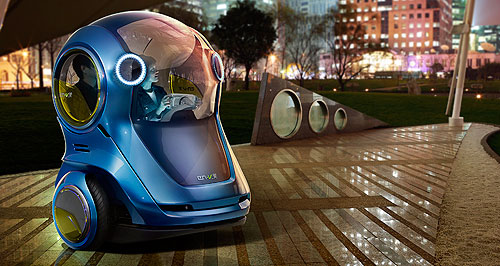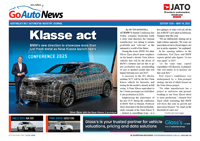Future models - Holden - EN-VHolden designs wacky commuter conceptIt's a Laugh: GM Holden designers conceived GM's EN-V Xiao, which is Chinese for 'laugh'. GM’s electric EN-V concept is a lighthearted 'Laugh' from Holden for World Expo25 Mar 2010 YOUNG Aussie designers at GM Holden have styled one of three futuristic two-wheel electric commuter concept vehicles that can cruise without driver input through city traffic snarls. The General Motors EN-V (Electric Networked-Vehicle) was unveiled in three versions – Xiao (Chinese for laugh), Jiao (pride) and Miao (magic) – which all ride on a next-generation Segway platform that balances on two wheels powered by two electric motors and a lithium-ion battery. The Xiao was crafted by Holden’s team at Port Melbourne, while the Jiao emerged from GM’s design house in Europe and the Miao from the GM Advanced Design Studio in California. The “lighthearted” Aussie design – looking like a deep-sea diving suit – is described by GM as “nautically inspired”. Unlike the original Segway device that was controlled by the rider leaning in the direction of travel, the new EN-V automatically keeps it balance while being driven by drive-by-wire controls for up to 40km at a top speed of 40km/h.  Left: EN-V Xaio interior and exterior. Middle: EN-V Jiao and Miao. Bottom: GM Segway Project PUMA. Left: EN-V Xaio interior and exterior. Middle: EN-V Jiao and Miao. Bottom: GM Segway Project PUMA.The two-seat vehicle was unveiled in China by GM and its Chinese partner Shanghai Automotive Industry Corp (SAIC) ahead of its debut at World Expo 2010, which opens in Shanghai on May 1. Holden design director Tony Stolfo said the EN-V project was completed over 15 months by Holden’s young designers whose talents would be recognised on the world stage. “This work has really broken the mould of the projects we undertake within the Holden design studio,” Mr Stolfo said. “The fact that our young designers were able to run with this project and develop it to such a high level really speaks volumes for the advanced design capabilities within Australia. “It has meant moving away from designing the traditional elements of a motor vehicle to develop new themes and technologies that might some day define the way we live our lives. “Much of what we have learned during this project will help us in our ongoing efforts to meet the many transport challenges associated with a growing population.” Design manager Aaron Deneweth oversaw the project, while lead designer Frank Rudolph was responsible for the final exterior theme. A group led by Holden chief designer of colour and trim, Sharon Gauci, worked with all three GM studios to develop the colours and materials required for each EN-V concept. The EN-V is GM’s vision of personal mobility in the crowded cities of the future when a 60 per cent of a world population of eight billion will be living in megacities around the globe. GM says four EN-Vs can occupy the road space of one conventional car while running on electricity to address environmental issues. GM China Group president and managing director Kevin Wale – a former GM Holden executive director – said the EN-V created a new vehicle DNA through the convergence of electrification and connectivity. “It provides an ideal solution for urban mobility that enables future driving to be free from petroleum and emissions, free from congestion and accidents, and more fun and fashionable than ever before,” he said. GM says the EN-V’s platform evolved from its Personal Urban Mobility and Accessibility (PUMA) prototype developed by Segway in 2009. Segway also worked collaboratively with GM on the EN-V platform that propels the various EN-Vs, with an electric motor in each of its two wheels which also act as brakes. Balanced by “dynamic stabilisation technology”, the EN-V can carry two passengers and light cargo without tipping over. GM says it can be operated manually by drive-by-wire controls or autonomously, using the Global Positioning System (GPS), vehicle-to-vehicle communications and distance-sensing technologies to automatically navigate through cities. It apparently can select the fastest route based on real-time traffic information while the ‘driver’ relaxes on Facebook or its 2030 equivalent. “The ability to communicate with other vehicles and with the infrastructure could dramatically reduce the number of vehicle accidents,” GM says. “Using vehicle-based sensor and camera systems, EN-V can “sense” what’s around it, allowing the vehicle to react quickly to obstacles or changes in driving conditions. “For example, if a pedestrian steps out in front of the vehicle, EN-V will decelerate to a slower and safer speed and stop sooner than today’s vehicles.” The EN-V can be plugged into a conventional household electricity socket for recharging, with the vehicle communicating with the grid to determine the best time to recharge according to grid load. GM defends the EN-V’s 40km range and 40km/h top speed, saying these are more than adequate in urban stop-start traffic which, it predicts, will only get worse. It also says some of the smart features of EN-V, such as its crash avoidance technology, will make it into other vehicles in future. The EN-V weighs less than 500kg – about one third of the weight of a conventional car at 1500kg – and is about 1.5 meters long – again about one third the size. Critically for city commuters, about five EN-Vs can be parked in one conventional parking spot. GM’s global vice president of research and development Alan Taub said the EN-V concept represented a major breakthrough GM’s research on vehicle autonomy. “The building blocks that enable the autonomous capabilities found on the EN-V concept such as lane departure warning, blind zone detection and adaptive cruise control are being used in some GM vehicles on the road today,” he said. Each of the three EN-V versions was given its own character by the global design teams, which were given freedom to explore new ideas on a single platform. The Holden-designed Xiao was described as offering “a more lighthearted appeal”, with its “gumball blue” paint and nautical-inspired design. Miao – designed in Europe - takes most of its design cues from the consumer electronics industry, while making extensive use of LED accent lighting. Jiao is said to take its design influence from bullet trains and Chinese opera masks. EN-V’s unveiling in Shanghai was no coincidence – GM believes the sprawling Chinese metropolis could well use vehicles such as these. The vehicles will be shown at GM-SAIC’s stand at the World Expo, which will run until October.  Read more8th of October 2009  Tokyo show: Nissan rolls out its Land GliderLand Glider EV to headline Nissan’s Tokyo wares as Infiniti confirms its first hybrid7th of August 2009  BMW to launch own-label eco brandBMW to market its Megacity electric car and other green vehicles under new sub-brand |
Click to shareHolden modelsResearch Holden Motor industry news |
















Facebook Twitter Instagram